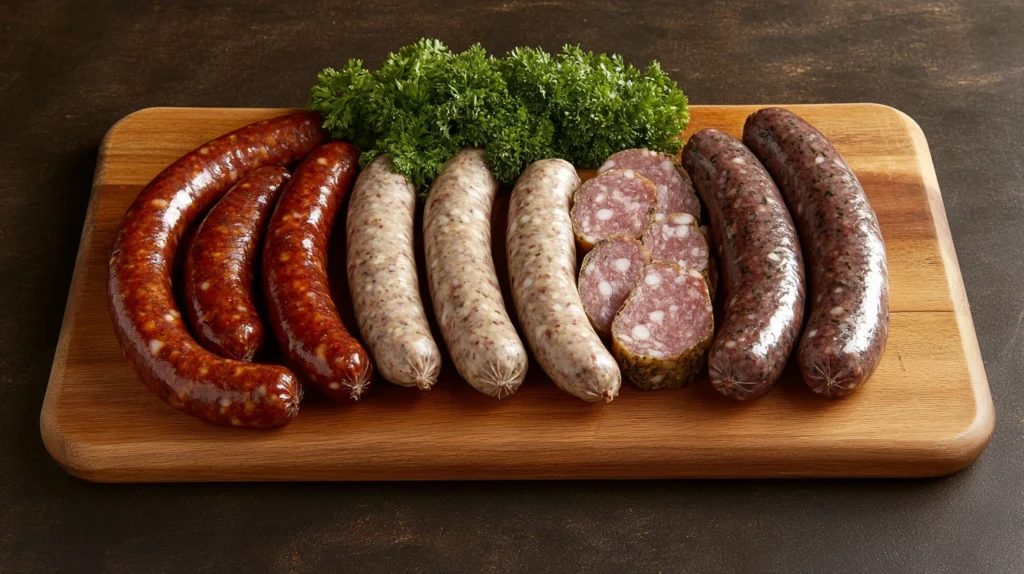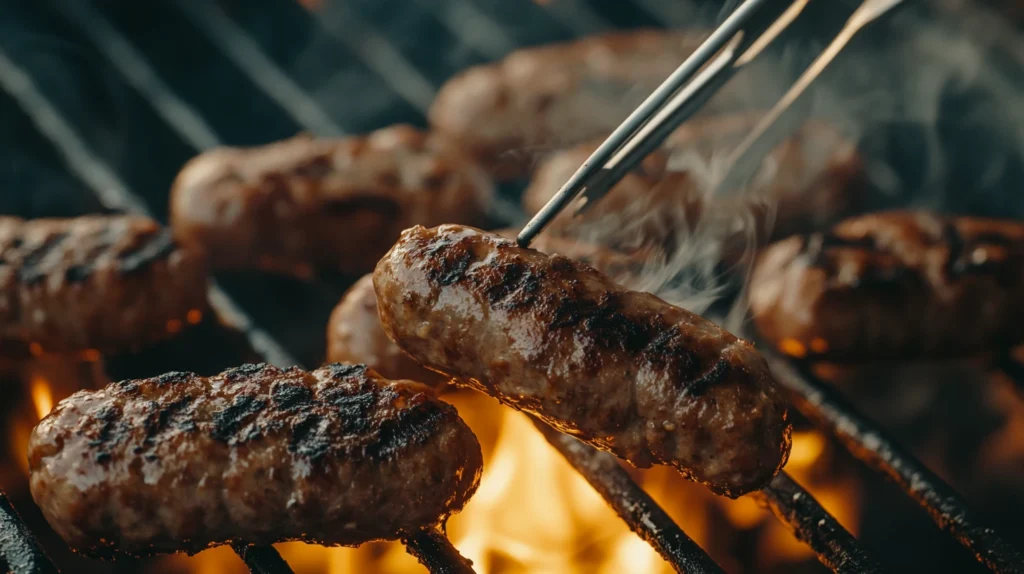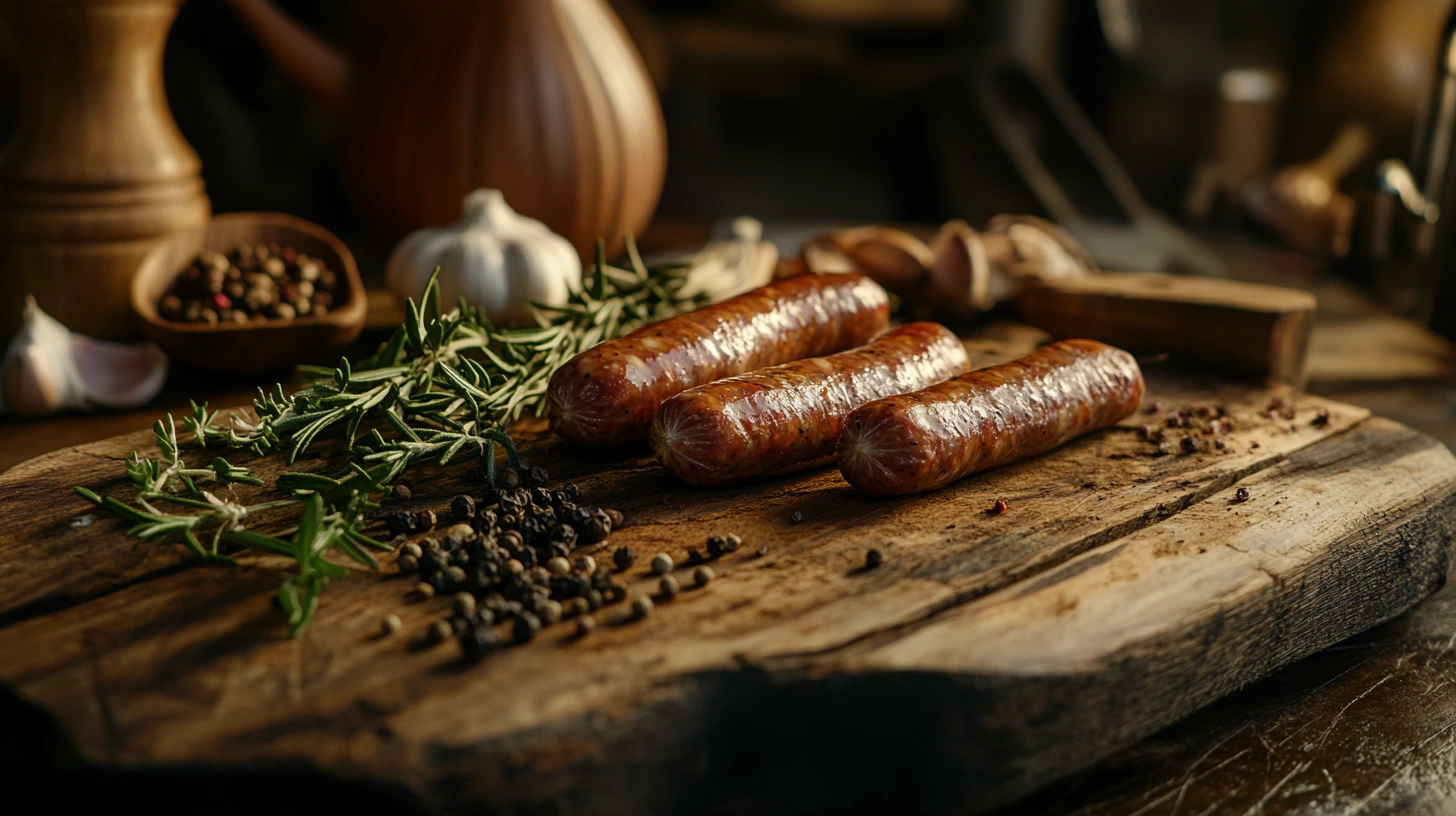Beef sausage is a flavorful and protein-rich food enjoyed by millions worldwide. Whether grilled, smoked, or pan-fried, its rich taste and juicy texture make it a favorite in many cuisines. Originating centuries ago as a way to preserve meat, beef sausage has evolved into a culinary staple, with countless varieties found across different cultures.
From breakfast links to spicy chorizo, beef sausages come in many forms, each offering unique flavors and textures. They can be enjoyed on their own, paired with bread, or used in stews, pasta, and other dishes. Beyond taste, beef sausage is also a great source of protein, iron, and essential vitamins, though moderation is key due to its fat and sodium content.
This article explores everything about beef sausage—its types, nutritional benefits, cooking methods, and even a homemade recipe. Whether you’re a food enthusiast or simply curious about this popular meat product, this guide will help you appreciate the delicious world of beef sausages.

What is Beef Sausage?
Beef sausage is a type of sausage made primarily from beef, mixed with seasonings, herbs, and sometimes fillers such as breadcrumbs or starch. It is typically encased in either natural casings (made from animal intestines) or synthetic casings and can be cooked, smoked, or dried depending on the variety.
Ingredients of Beef Sausage
The ingredients of beef sausage can vary based on the recipe, but the primary components usually include:
Ground Beef – High-quality beef, often with a balanced fat-to-meat ratio for juiciness and flavor.
Salt – Essential for seasoning and preserving the meat.
Spices and Herbs – Garlic, black pepper, paprika, coriander, fennel seeds, and chili flakes are commonly used.
Binding Agents – Some sausages contain breadcrumbs, flour, or cornstarch to maintain texture.
Preservatives (Optional) – Some commercially produced beef sausages contain nitrates or nitrites to extend shelf life and enhance color.
How is Beef Sausage Made?
The process of making beef sausage includes several steps:
Meat Selection and Grinding – High-quality cuts of beef, such as chuck or brisket, are selected, trimmed of excess fat, and ground to the desired consistency.
Seasoning and Mixing – Spices and herbs are mixed thoroughly into the ground beef to distribute flavors evenly.
Stuffing into Casings – The seasoned meat is then stuffed into natural or artificial casings using specialized sausage-making equipment.
Curing and Drying (if applicable) – Some sausages, such as salami, undergo a curing and drying process to develop deeper flavors.
Cooking or Smoking (if applicable) – Certain beef sausages, like smoked beef sausages, are pre-cooked using a smoker or grill before packaging.
Types of Beef Sausage
Beef sausages come in a wide variety, each with its own unique preparation methods, flavors, and uses. From fresh to cured, smoked to dry-aged, these sausages cater to different tastes and culinary traditions worldwide. Here are some of the most popular types of beef sausage:

1. Fresh Beef Sausage
Beef sausages are uncooked and require refrigeration until they are cooked. They are made from raw ground beef mixed with spices and seasonings and are usually sold in links or patties. Examples include:
Breakfast Sausage – Mildly seasoned and often enjoyed with eggs and toast.
Beef Bratwurst – A German-style sausage, typically grilled or pan-fried.
2. Smoked Beef Sausage
Smoked beef sausages undergo a smoking process that enhances their flavor and preserves them for longer periods. The smoking process can be hot (fully cooking the sausage) or cold (partially cooking it). Examples include:
Beef Kielbasa – A Polish sausage known for its smoky and garlicky flavor.
Texas Smoked Sausage – A bold-flavored sausage commonly found in barbecue dishes.
3. Dry-Cured Beef Sausage
Dry-cured sausages are preserved using salt and air-drying methods, which intensify their flavors and extend their shelf life. These sausages are typically sliced and eaten without cooking. Examples include:
Beef Salami – A fermented and dried sausage with a tangy, slightly spicy taste.
Beef Pepperoni – A spicy, dry-cured sausage used in pizzas and sandwiches.
4. Fermented Beef Sausage
Fermented sausages undergo a controlled fermentation process, where beneficial bacteria develop the sausage’s unique tangy flavor while preserving it naturally. Examples include:
Beef Chorizo – A Spanish and Mexican sausage, sometimes sold raw (for cooking) or cured (ready to eat).
Sujuk (Sucuk) – A highly spiced, dry-fermented beef sausage popular in the Middle East and the Balkans.
5. International Varieties of Beef Sausage
Different cultures have developed unique beef sausages based on local spices, cooking methods, and traditions. Some notable international beef sausages include:
Boerewors (South Africa) – A coiled beef sausage with coriander and vinegar.
Merguez (North Africa) – A spicy beef sausage flavored with harissa and cumin.
Loukaniko (Greece) – A Greek beef sausage infused with orange zest and herbs.
Beef sausages come in many forms, from fresh and juicy to dry-cured and intensely flavorful. Whether enjoyed as a snack, in sandwiches, or as part of a main dish, each type offers a unique culinary experience.
How Beef Sausage is Made
The process of making beef sausage is both an art and a science, combining high-quality ingredients with careful preparation techniques. Whether prepared at home or in commercial settings, the steps remain largely the same, ensuring flavor, texture, and safety. step-by-step guide on how beef sausage is made.
1. Selection of Beef
The foundation of any great beef sausage starts with the right cut of beef. Sausage makers typically choose cuts that contain a balance of meat and fat, such as:
Chuck – A well-marbled cut that provides moisture and flavor.
Brisket – A flavorful cut with an ideal fat ratio for sausage-making.
Round – A leaner cut often mixed with fatty cuts for balance.
Fat content is crucial in beef sausage, as it affects juiciness and texture. Most recipes aim for a 70% lean meat to 30% fat ratio.
2. Grinding the Meat
The beef is selected, it is coarsely or finely ground depending on the desired texture of the sausage.
Coarse Grind – Provides a chunky texture, ideal for rustic sausages like Boerewors.
Fine Grind – Produces a smoother consistency, used for sausages like hot dogs.
The grinding process helps evenly distribute fat and ensures a uniform consistency.
3. Seasoning the Meat
Grinding, the beef is seasoned with spices, herbs, and salt to develop its unique flavor. Common seasonings include:
Salt & Pepper – The base seasoning for all sausages.
Garlic & Onion Powder – Adds depth of flavor.
Paprika & Chili Flakes – For heat and smokiness.
Cumin & Coriander – Used in Middle Eastern and South African styles.
Oregano & Fennel Seeds – Classic Italian sausage flavors.
Fermented sausages, starter cultures are added to encourage beneficial bacterial growth for preservation.
4. Stuffing into Casings
Once seasoned, the meat mixture is stuffed into casings, which provide structure and shape. Casings can be:
Natural Casings – Made from animal intestines, offering a traditional snap and chew.
Collagen Casings – Man-made but mimic natural casings.
Cellulose Casings – Often used for skinless sausages like hot dogs.
Stuffing is done using a sausage stuffer to ensure even filling and prevent air pockets, which can affect cooking and preservation.
5. Curing and Drying (If Applicable)
Some sausages undergo a curing and drying process to develop deeper flavors and extend shelf life.
Smoked Beef Sausages – Placed in a smoker at controlled temperatures to infuse rich flavors.
Dry-Cured Sausages – Aged in temperature-controlled environments, where they lose moisture and intensify in flavor.
Curing agents like nitrates or nitrites are sometimes used to enhance color and prevent bacterial growth.
6. Cooking or Packaging
Depending on the type of sausage, the final step involves cooking or packaging:
Fresh Beef Sausages – Sold raw and require cooking before consumption.
Pre-Cooked Sausages – Partially cooked for convenience, requiring only reheating.
Dry-Cured Sausages – Packaged and ready to eat without additional cooking.
Homemade vs. Commercial Beef Sausage
| Factor | Homemade Sausage | Commercial Sausage |
|---|---|---|
| Ingredients | Customizable, fresh | May contain preservatives and fillers |
| Flavor Control | Full control over spices | Pre-made seasoning blends |
| Processing | Manual stuffing and grinding | Mass-produced with machines |
| Shelf Life | Shorter, requires freezing | Longer, often vacuum-sealed |
Making beef sausage is a rewarding process that allows customization of flavors and ingredients. Whether handmade or store-bought, a well-prepared sausage is a delicious addition to any meal.
Nutritional Value of Beef Sausage
Beef sausage is not only delicious but also a good source of essential nutrients like protein, iron, and vitamins. However, depending on how it’s made, beef sausage can also contain high levels of fat, sodium, and preservatives. In this section, we’ll break down the nutritional value of beef sausage, its benefits, and potential health concerns.
1. Macronutrient Breakdown
The nutritional content of beef sausage varies based on ingredients, preparation methods, and portion size. Below is an approximate breakdown of nutrients per 100 grams (3.5 oz) of typical:
| Nutrient | Amount |
|---|---|
| Calories | 250-350 kcal |
| Protein | 12-16g |
| Total Fat | 20-30g |
| Saturated Fat | 8-12g |
| Carbohydrates | 1-3g (if no fillers are used) |
| Sodium | 600-1000mg |
| Cholesterol | 40-70mg |
| Iron | 10-15% of Daily Value (DV) |
| Vitamin B12 | 20-30% of DV |
Note: The values above can vary significantly based on the type (fresh, smoked, cured) and whether it contains fillers like breadcrumbs or starch.
2. Health Benefits of Beef Sausage
Despite some concerns, offers several nutritional benefits:
High-Quality Protein – a rich source of protein, essential for muscle growth, repair, and overall health. A 100g serving provides about 12-16g of protein.
Iron-Rich – Beef contains heme iron, which is more easily absorbed by the body compared to plant-based iron. This is especially beneficial for individuals prone to anemia.
Good Source of Vitamin B12 – Essential for nerve function, red blood cell production, and energy metabolism. A serving provides up to 30% of the daily requirement for B12.
Zinc for Immune Support – Zinc helps support immune function, wound healing, and cellular growth. contributes a significant amount of daily zinc intake.
Beef sausage is rich in essential nutrients, including protein, iron, and B vitamins. While it can be higher in fat than some alternatives, it provides a delicious, hearty option for those looking for a protein boost. If you’re seeking healthier sausage alternatives, chicken sausage is a great choice.
3. Health Concerns of Beef Sausage
While has nutritional benefits, it also comes with some health concerns:
High in Saturated Fat – A single serving can contain 8-12g of saturated fat, which may contribute to high cholesterol and heart disease if consumed excessively.
Sodium Content – Many commercial beef sausages contain 600-1000mg of sodium per serving, which can raise blood pressure and increase the risk of cardiovascular issues.
Preservatives (Nitrates & Nitrites) – Some processed sausages contain sodium nitrates or nitrites, which help preserve color and flavor but have been linked to health risks when consumed in excess. Opting for nitrate-free or natural alternatives is a healthier choice.
4. How to Choose a Healthier Beef Sausage
To enjoy a balanced diet, consider these healthier options:
Choose Leaner Cuts – Opt for grass-fed or lean beef sausage with less fat content.
Look for Nitrate-Free Labels – Avoid processed sausages with sodium nitrates or nitrites.
Lower Sodium Options – Choose brands with reduced sodium content (under 500mg per serving).
Check the Ingredient List – Avoid sausages with artificial fillers, MSG, or excessive additives.
5. Comparing Beef Sausage to Other Meats
| Meat Type | Protein (per 100g) | Fat | Sodium | Healthiest Choice? |
|---|---|---|---|---|
| Beef Sausage | 12-16g | 20-30g | 600-1000mg | Moderation needed |
| Chicken Sausage | 15-20g | 8-12g | 400-700mg | Healthier alternative |
| Turkey Sausage | 14-18g | 6-10g | 350-600mg | Leaner option |
| Pork Sausage | 11-15g | 25-35g | 700-1200mg | ❌ Higher in fat & sodium |
| Plant-Based Sausage | 10-18g | 5-15g | 300-600mg | Vegan-friendly |
If you’re looking for a healthier alternative, turkey or chicken sausage can provide similar protein with less fat and sodium.
Final Thoughts on Nutrition
A delicious protein source, but its fat, sodium, and preservative content mean it should be consumed in moderation. Choosing leaner, nitrate-free, and lower-sodium options can make it a healthier addition to your diet.
Best Ways to Cook Beef Sausage
Cooking beef sausage properly enhances its flavor, texture, and overall enjoyment. Whether you prefer a smoky, grilled taste or a juicy, pan-fried bite, different cooking methods bring out unique qualities in the sausage. Here, we explore the best ways to prepare , along with tips for achieving the perfect texture and flavor.

1. Grilling Beef Sausage 🔥
Why Grill?
Grilling gives a smoky, slightly charred exterior while keeping the inside juicy and flavorful. This method is especially popular for barbecue-style sausages, such as Texas smoked beef sausage or bratwurst.
How to Grill:
Preheat the Grill – Set to medium heat (350-400°F / 175-200°C) to prevent burning.
Prepare the Sausages – Prick lightly with a fork to allow steam to escape and prevent splitting.
Grill Indirectly First – Cook sausages away from direct heat for about 10-12 minutes, turning occasionally.
Sear Over Direct Heat – Move sausages over direct flames for 2-3 minutes to create grill marks.
Check Internal Temperature – Use a meat thermometer; should reach 160°F (71°C).
Pro Tip: Brush sausages with olive oil or melted butter before grilling for extra crispiness.
2. Pan-Frying Beef Sausage
Why Pan-Fry?
Pan-frying is one of the easiest and quickest methods, perfect for cooking breakfast sausages or smaller sausage links. It provides a crispy exterior while keeping the inside moist.
How to Pan-Fry:
Preheat a Pan – Use a non-stick or cast-iron skillet over medium heat.
Add a Little Oil – Use butter, olive oil, or beef tallow for a richer taste.
Cook Evenly – Place sausages in the pan and cook for 8-10 minutes, turning every few minutes.
Cover & Steam (Optional) – Add a splash of water, cover with a lid, and let the sausages steam for 2-3 minutes to ensure thorough cooking.
Pro Tip: For an extra crispy crust, let the sausages brown without moving them for the first 3 minutes.
3. Boiling Beef Sausage
Why Boil?
Boiling is ideal for pre-cooking fresh sausages before grilling or frying. It helps lock in moisture and prevent burning.
How to Boil :
Bring Water to a Simmer – Fill a pot with water and heat to 180-200°F (82-93°C) (do not boil aggressively).
Add Sausages – Submerge the sausages and let them simmer for 10-15 minutes.
Remove & Pat Dry – After boiling, let sausages rest for a few minutes before grilling or pan-frying.
Pro Tip: Use beer, broth, or flavored stock instead of water for enhanced taste.
4. Baking Beef Sausage
Why Bake?
Baking is a healthier, hands-free cooking method that ensures even cooking. It’s perfect for bulk cooking or preparing sausages with vegetables.
How to Bake:
Preheat the Oven – Set to 375°F (190°C).
Line a Baking Sheet – Use parchment paper or a lightly greased pan.
Arrange Sausages Evenly – Place sausages with space between them to allow heat circulation.
Bake for 25-30 Minutes – Flip sausages halfway for even browning.
Check Internal Temperature – Ensure the sausages reach 160°F (71°C).
Pro Tip: Add bell peppers, onions, or cherry tomatoes to the tray for a flavorful side dish.
5. Smoking Beef Sausage
Why Smoke?
Smoking adds a deep, rich flavor and preserves it for longer. This is the traditional method used for making Texas-style or Kielbasa sausage.
How to Smoke :
Preheat the Smoker – Set it to 225°F (107°C).
Choose Wood Chips – Use hickory, applewood, or mesquite for different flavors.
Place Sausages on the Rack – Ensure they are not touching each other.
Smoke for 1-2 Hours – Cook until the internal temperature reaches 160°F (71°C).
Rest Before Serving – Let sausages sit for 5 minutes before slicing.
Pro Tip: Brush with a maple glaze or honey mustard for a caramelized finish.
Comparison of Cooking Methods
| Method | Pros | Cons | Best For |
|---|---|---|---|
| Grilling 🔥 | Smoky flavor, crispy skin | Requires outdoor grill | Barbecue sausages, bratwurst |
| Pan-Frying 🍳 | Quick, crispy | Can be greasy | Breakfast sausages, chorizo |
| Boiling ♨️ | Moist, even cooking | Less flavor if plain water is used | Pre-cooking fresh sausages |
| Baking 🍞 | Hands-free, even cooking | Longer cooking time | Bulk cooking, oven-roasted dishes |
| Smoking 🚬 | Deep, complex flavors | Requires a smoker | Smoked beef sausages, gourmet recipes |
Final Thoughts on Cooking
The best way to cook depends on your preference and the type of sausage. Grilling and smoking are perfect for barbecue lovers, while pan-frying and baking work well for quick, easy meals. No matter the method, always check the internal temperature (160°F / 71°C) to ensure safe consumption.
Beef sausage isn’t the only tasty beef product out there. For those who love smoky flavors, high-protein beef alternatives like beef bacon are another great option. Both can be used to add depth to various dishes.
Looking for ways to incorporate beef sausage into your meals? Try adding it to pasta, casseroles, or breakfast scrambles. You can even substitute it in some of these ground beef recipes for a new twist.
Frequently Asked Questions
1. What is Beef Sausage?
A type of sausage made primarily from ground beef, mixed with seasonings, spices, and sometimes fillers like breadcrumbs or starch. It can be fresh, smoked, cured, or fermented, depending on the preparation method. Beef sausage is often encased in either natural casings (animal intestines) or synthetic casings and can be found in many cuisines worldwide. Common varieties include beef bratwurst, beef chorizo, and beef salami.
2. Are Beef Sausages Better Than Pork?
It depends on your dietary preference!
Here’s a comparison of beef and pork sausages based on nutrition and taste:
| Factor | Beef Sausage | Pork Sausage |
|---|---|---|
| Protein | 12-16g per 100g | 11-15g per 100g |
| Fat Content | 20-30g (varies) | 25-35g (higher) |
| Sodium | 600-1000mg | 700-1200mg |
| Flavor | Rich, bold, slightly smoky | Savory, fatty, juicy |
| Healthier Option? | ✅ If lean cuts & low sodium | ❌ Higher in fat & salt |
Beef sausage is often leaner than pork sausage, making it a better choice for people watching their fat intake.
However, pork sausage tends to be juicier due to its higher fat content, which gives it a richer taste.
If you prefer a leaner, high-protein option, go for grass-fed beef sausage or turkey sausage.
3. Is Beef Sausage the Same as Kielbasa?
❌ No, beef sausage and kielbasa are different!
Kielbasa is a traditional Polish sausage that can be made from pork, beef, or a mix of both. It is usually smoked, garlicky, and slightly coarse in texture.
| Feature | Beef Sausage | Kielbasa |
|---|---|---|
| Meat Used | 100% beef | Pork, beef, or both |
| Seasoning | Varies (herbs, spices) | Garlic, marjoram, pepper |
| Texture | Can be smooth or coarse | Coarse and chunky |
| Cooking Methods | Grilled, fried, boiled | Smoked, boiled, grilled |
If you see beef kielbasa, it’s a version of Polish sausage made only with beef.
Regular beef sausages can have different flavors and textures depending on the type and region they come from.
4. What is the Difference Between Andouille Sausage and Beef Sausage?
Andouille sausage is a spicy, smoked sausage originating from France but commonly associated with Cajun and Creole cuisine in Louisiana. It is traditionally made from pork, but beef versions also exist.
| Feature | Beef Sausage | Andouille Sausage |
|---|---|---|
| Meat Used | 100% beef | Pork (or beef versions) |
| Seasoning | Varies (mild to spicy) | Spicy, smoky, garlic-heavy |
| Texture | Can be smooth or coarse | Coarse, chopped meat |
| Preparation | Fresh, smoked, or cured | Always smoked & pre-cooked |
| Used In | Grilled, breakfast, sandwiches | Jambalaya, gumbo, Cajun dishes |
Beef sausage is more versatile, while Andouille has a distinct spicy, smoky kick.
If you’re looking for a smoked, bold-flavored sausage, Andouille is a great choice for dishes like gumbo, jambalaya, and étouffée.
Conclusion
Beef sausage is a versatile, flavorful, and protein-packed food enjoyed in various cuisines worldwide. Whether grilled, smoked, or pan-fried, it offers a rich taste and satisfying texture. However, like any processed meat, it should be consumed in moderation, especially when high in sodium and preservatives.
For the healthiest option, choose nitrate-free, low-sodium beef sausages, or make your own at home using lean cuts and natural seasonings. By experimenting with different cooking methods, seasonings, and side dishes, you can enjoy beef sausage in a variety of delicious ways.

Homemade Beef Sausage – Juicy & Flavorful
Equipment
- Large mixing bowl
- Measuring spoons
- Kitchen scale (optional)
- Meat grinder (if using whole cuts of beef)
- Sausage stuffer (if making links)
- Parchment paper or plastic wrap
- Skillet or grill (for cooking)
Ingredients
- 2 lbs ground beef preferably 80/20 fat ratio
- 1 ½ tsp salt
- 1 tsp black pepper
- 1 tsp smoked paprika
- 1 tsp garlic powder
- 1 tsp onion powder
- ½ tsp crushed red pepper flakes optional, for heat
- 1 tsp dried thyme
- ½ tsp ground coriander
- ½ tsp ground nutmeg
- 1 tbsp Worcestershire sauce
- ¼ cup ice-cold water
- 1 tsp brown sugar optional, for slight sweetness
- Natural or synthetic sausage casings if making links
Instructions
- Step 1: Prepare the Meat
- If using whole cuts of beef, grind them using a meat grinder. Otherwise, use pre-ground beef.
- Place the ground beef in a large mixing bowl.
- Step 2: Season the Meat
- Add salt, black pepper, smoked paprika, garlic powder, onion powder, red pepper flakes, thyme, coriander, nutmeg, and brown sugar.
- Pour in Worcestershire sauce and ice-cold water to keep the mixture moist.
- Mix thoroughly using your hands or a stand mixer until well combined.
- Step 3: Shape the Sausage
- If making sausage patties, shape the mixture into small discs and place them on parchment paper.
- If making links, soak the sausage casings in warm water for 30 minutes, then rinse thoroughly.
- Use a sausage stuffer to fill the casings with the seasoned meat mixture, ensuring they are not overfilled.
- Twist the sausages into links at desired lengths and tie off the ends.
- Step 4: Cook the Sausage
- Heat a skillet or grill over medium heat.
- Cook the sausage patties or links for 4-5 minutes per side until browned and cooked through (internal temperature of 160°F).
- Let them rest for a few minutes before serving.
- Step 5: Storage
- Store uncooked sausage in an airtight container in the refrigerator for up to 3 days.
- For longer storage, freeze for up to 3 months.
Notes
Feel free to adjust the spices to match your taste preferences.
For a smoky flavor, try adding liquid smoke or grilling the sausages.
If you don’t have casings, shape the mixture into logs and wrap in plastic wrap before refrigerating.
